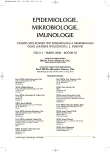-
Medical journals
- Career
Outbreak of Marburg Hemorrhagic Fever in Angola
Authors: J. Smetana; R. Chlíbek; M. Vacková
Authors‘ workplace: Katedra epidemiologie Fakulty vojenského zdravotnictví Univerzity obrany, Hradec Králové
Published in: Epidemiol. Mikrobiol. Imunol. 55, 2006, č. 2, s. 63-67
Overview
Marburg hemorrhagic fever is a rare acute viral fever illness with a serious clinical course often leading to a fatal outcome. The lethality rate ranges between 25 and 80 %. Both the virus reservoir and mode of transmission to humans are unknown. Close contact with body fluids of infected persons is prerequisite for secondary human to human transmission. Seriousness of the infection is underlined by the unavailability of specific treatment and vaccination.
The outbreak in Angola in 2004–2005 accounted for the highest prevalence of the disease recorded to date. As many as 374 cases were reported by August 23, 2005, 329 of these were fatal; the lethality rate was 88 %. In comparison with the previous outbreaks, the afflicted area is unusually vast, includes populated zones, and intensive secondary transmission is observed.Key words:
Marburg hemorrhagic fever – epidemiology – outbreak – Angola.
Labels
Hygiene and epidemiology Medical virology Clinical microbiology
Article was published inEpidemiology, Microbiology, Immunology

2006 Issue 2-
All articles in this issue
- Long-term Experience with Testing Family and Sexual Contacts of HBsAg Positive Persons
- West Nile Virus
- Outbreak of Marburg Hemorrhagic Fever in Angola
- Epidemiological Characteristics of Diabetes Mellitus in Slovakia, 1992–2002
- Medium with Amikacin for Laboratory Diagnosis of Beta-haemolytic Streptococci
- Epidemiology, Microbiology, Immunology
- Journal archive
- Current issue
- Online only
- About the journal
Most read in this issue- West Nile Virus
- Medium with Amikacin for Laboratory Diagnosis of Beta-haemolytic Streptococci
- Outbreak of Marburg Hemorrhagic Fever in Angola
- Epidemiological Characteristics of Diabetes Mellitus in Slovakia, 1992–2002
Login#ADS_BOTTOM_SCRIPTS#Forgotten passwordEnter the email address that you registered with. We will send you instructions on how to set a new password.
- Career

